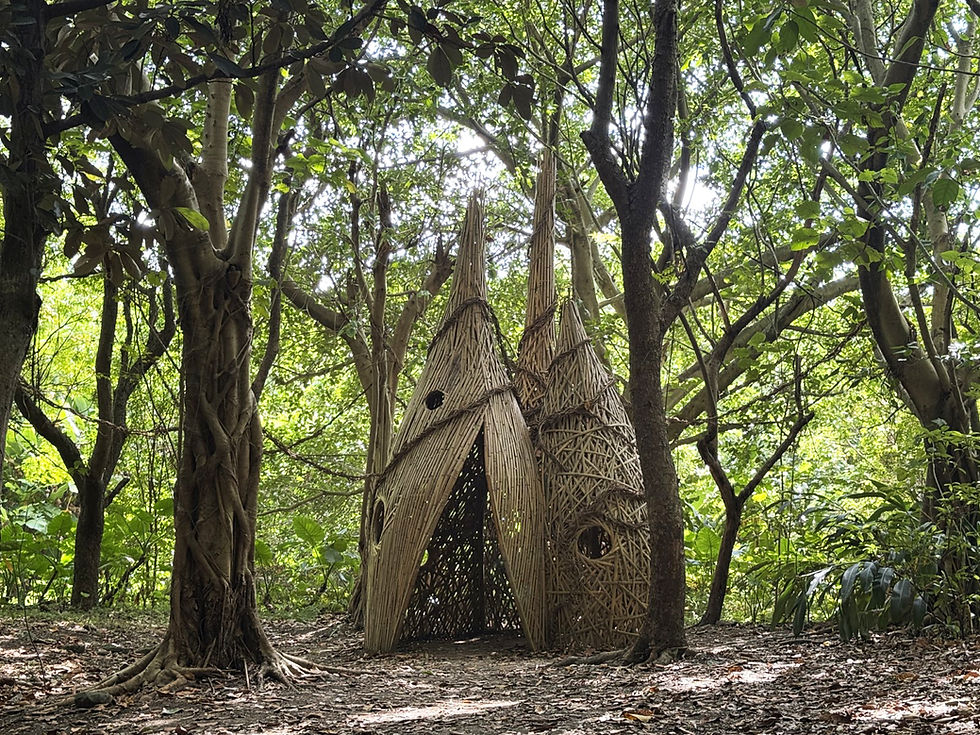浮脈 / Aerial Habitat
- Lee, Kuei-Chih

- 9月10日
- 讀畢需時 6 分鐘




作品名稱:浮脈
創作者:緯創人文基金會/緯創資通 X 李蕢至
媒材:竹、藤、鋼筋
尺寸:375cm(L)x335cm(W)x 600cm(H)
地點:關渡自然公園,台北市,台灣
年代:2025
“2025關渡國際自然藝術季_看見關渡,自然作為一種解方”
創作理念
《浮脈》是一座設置在關渡自然公園樹林間的竹編雕塑,靈感來自榕樹垂掛的氣根。三根像氣根般的粗壯結構彼此交錯、支撐,組成了一個可以走進去、停留、甚至靜靜沉思的空間。這些像是生命剛開始萌芽的根系,往下扎進土裡,也向上延伸到空中,把地面與天空、濕地與林間的能量連接起來。
榕樹在關渡自然公園中有著悠久的歷史,它們不只是風景的一部分,更深深參與了這片土地的生態記憶。走進這座氣根狀的雕塑,就像走進一棵榕樹的心,從心開始,從根出發,也喚醒我們與自然原本就存在的感知力與連結。
整個雕塑從地面長出來,就像是會呼吸的生命體,看似浮動,卻與土地緊緊連結。榕樹的氣根象徵著自然界強韌的生命力,它們從地底鑽出、交織、最後茂盛生長。在這個場域裡,這些結構也和濕地的水氣、陽光和風產生互動,呈現出生生不息、持續流動的狀態。
我把這件作品命名為《浮脈》。「浮」這個字,來自古詩中對季節變化和生命無常的抒情,也呼應莊子「浮生若夢」的哲思。不只是指短暫與漂泊,更是一種順著環境、自由變動的生活態度。而「脈」代表萬物之間看不見的連結,就像濕地裡錯綜的根系、水脈與能量,彼此牽動,構成自然的循環與活力。
作品以竹子與藤等天然材料手工編織而成,保留了手工製作的質感與時間的痕跡。雕塑的上方與側邊設計了圓形開口,就像種子裂開或是榕樹的氣孔,不只是觀察鳥類的窗,也是光與風進入的通道,象徵新生命誕生的起點。
現代人已經與自然越來越疏遠了。《浮脈》希望透過「氣根」這個意象,帶領觀眾重新思考我們與土地的連結。真正的解方,不是改變自然,而是重新學習如何與自然共處。在這座用氣根交織而成的空間裡,我們不只是欣賞的觀眾,而是整個生態的一份子,也呼應2025年「關渡國際自然藝術季」的主題:「自然作為一種解方」。
走進《浮脈》,就是走入一場從根出發的對話,一場與土地、時間與未來靜靜進行的深層對話。
從環境的修復到人心的重建,從資源的保育到感知的復甦。
《浮脈》這件作品,是緯創人文基金會第三度參與「關渡國際自然藝術季」的重要創作,延續基金會自2022年起與台北市野鳥學會共同推動的「月池埤塘認養計畫」與生態保育行動。從初期對濕地埤塘的守護,到提供環境教育、改善賞鳥設施與生態缸管理,再到近年投入藝術創作,基金會持續以多元形式實踐對關渡自然公園的長期關懷與承諾。
2023年的《翼起祝福》是緯創人首次以企業名義參與藝術創作,象徵企業對濕地的第一份藝術性回應;2024年的《翼起回家》則強化了生態守護與棲地永續的概念。而來到2025年,《浮脈》不僅延續這份關注,更進一步深化藝術作為「解方」的可能性。
《浮脈》以榕樹氣根為靈感,呼應了關渡自然公園中榕樹長年與濕地共生的歷史意象,藉由可進入的氣根結構,邀請觀眾走入大自然的心臟,重新感受與土地的連結。作品象徵著從根開始的思考與轉化,回應了2025年藝術季主題「自然作為一種解方」。這不僅是形式上的回應,更是行動上的延伸。
因此,《浮脈》在今年的藝術季中不僅是藝術品,更是一種象徵性的轉譯:代表緯創人文基金會從保育行動者到文化實踐者的轉化歷程,也展現企業如何透過藝術回應環境議題,以更深層的方式參與社會與生態的共構。它標誌著一種新的企業參與模式:不僅捐助,不僅關心,而是親自參與創造、與場域共鳴、與自然對話。
透過《浮脈》,我們看見一種新的合作想像:當保育與藝術、社群與企業、自然與人文真正交織在一起時,我們便能找到通往未來的脈絡與方向。
共同創作:
王小勤、王文君、王殿韻、王靖彤、朱其文、朱育萱、李幼麒、李淑玲、何沛諼、吳佳純、周文玲、周美秋、林中堯、林秀美、林志璿、林姵岑、林群雅、金鈺蓉、施俊逸、施宥瑜、洪櫻芬、唐劍秋、張元勳、張天勳、曹羽伶、陳永傑、陳禾榛、陳威銘、陳清村、許芳嘉、黃柏森、黃雅君、游智鈞、馮翠芬、鄒 琴、楊蕙禎、劉子晨、劉怡君、劉盈瑩、劉家昕、潘建銘、賴奕璇、蔡竹嘉、蔡燕華、鍾佩君、鍾權昱、戴宥薰、謝裕民、顏力行、蘇世軒、蘇姵儀、蘇毓傑
Title: “Aerial Habitat”
Artist: Wistron Foundation/Wistron Corporation X Kuei-Chih Lee
Materials: Bamboo, vine, steel
Dimensions: 375cm (L) × 335cm (W) × 600cm (H)
Location: Guandu Nature Park, Taipei, Taiwan
Year: 2025
2025 Guandu International Nature Art Festival – “Seeing Guandu: Nature as a Solution”
”Aerial Habitat” is a bamboo-woven sculpture installed in the forest of Guandu Nature Park, inspired by the aerial roots of banyan trees. Three robust root-like structures intersect and support one another, forming a space that invites people to step inside, linger, and contemplate. These forms resemble roots at the moment of sprouting—extending downward into the soil and upward into the air—connecting earth and sky, wetland and woodland energies.
Banyan trees have long histories within Guandu Nature Park. They are not merely part of the scenery but active participants in the ecological memory of this land. Entering this aerial-root-shaped sculpture is like stepping into the heart of a banyan tree—beginning from its roots, awakening our innate senses, and renewing our connection with nature.
The sculpture emerges from the ground like a breathing organism—seemingly afloat yet firmly anchored to the soil. Aerial roots symbolize the resilience of life in nature, as they pierce the earth, intertwine, and flourish. Here, the structures interact with the wetland’s humidity, sunlight, and wind, embodying a continuous rhythm of growth and renewal.
The name “Aerial Habitat”(浮脈) reflects this duality. “浮” echoes ancient Chinese poetry on seasonal change and the impermanence of life, resonating with Zhuangzi’s philosophy that “life drifts like a dream.” It speaks not only of transience but also of a flexible, adaptive way of living in harmony with the environment. “脈” refers to the invisible connections among all beings—like roots, water currents, and energies in wetlands—interlinked in cycles of vitality.
Handwoven from natural materials such as bamboo and vine, the work preserves the tactile traces of craftsmanship and time. Circular openings on the top and sides recall sprouting seeds or the pores of a banyan tree—windows for birdwatching, channels for light and wind, and symbols of new beginnings.
Modern people have become increasingly alienated from nature. “Aerial Habitat”(浮脈) aims to reconnect audiences with the roots of connection. The true “solution” lies not in reshaping nature but in relearning coexistence. Within this interlaced space of aerial roots, viewers are not mere observers but part of the living ecosystem—echoing the festival’s 2025 theme, “Nature as a Solution.” Entering ”Aerial Habitat” is to enter a dialogue that begins with the root: a deep conversation with the land, with time, and with the future.
From the restoration of the environment to the reconstruction of the human heart, from the conservation of resources to the perceived recovery.
“Aerial Habitat” represents the third collaboration between the Wistron Cultural and Educational Foundation and the Guandu International Nature Art Festival. It continues the Foundation’s long-term commitment to Guandu Nature Park, following its 2022 partnership with the Wild Bird Society of Taipei in adopting and protecting Moon Pond, as well as advancing habitat conservation.
This ongoing effort has included wetland preservation, environmental education, improvement of birdwatching facilities, and ecological tank maintenance. In recent years, it has expanded into artistic creation, integrating culture into conservation.
In 2023, Wings of Blessing marked Wistron’s first artistic participation as a corporation, symbolizing its initial creative response to wetlands. In 2024, Wings of Homecoming deepened the focus on ecological protection and habitat sustainability. In 2025, ”Aerial Habitat” both continues and expands this trajectory—exploring art itself as a form of “solution.”
Drawing inspiration from the banyan’s aerial roots, the work resonates with the long coexistence of banyan trees and wetlands at Guandu. By inviting visitors into a root-formed structure, it symbolically leads them into the heart of nature, urging a renewed connection with the land. This is not only a formal artistic response but an active extension of the festival theme, “Nature as a Solution.”
Thus, ”Aerial Habitat” functions not just as an artwork but as a symbolic translation of Wistron’s evolving role—from conservation actor to cultural practitioner. It demonstrates how corporations can respond to environmental issues through art, engaging more deeply in the co-creation of society and ecology.
It marks a new model of corporate participation: not only giving, not only observing, but co-creating—resonating with place, and entering into dialogue with nature.
Through ”Aerial Habitat”, we glimpse a new horizon of collaboration: when conservation and art, community and enterprise, nature and culture truly intertwine, we may discover the living veins and pathways that lead toward the future.
























留言